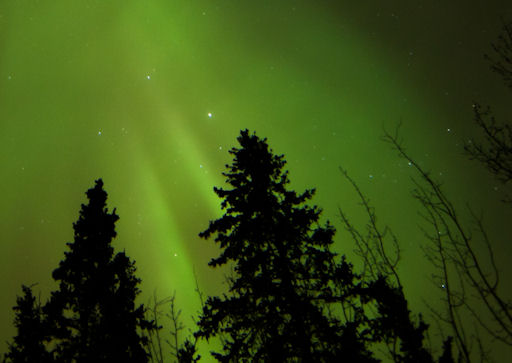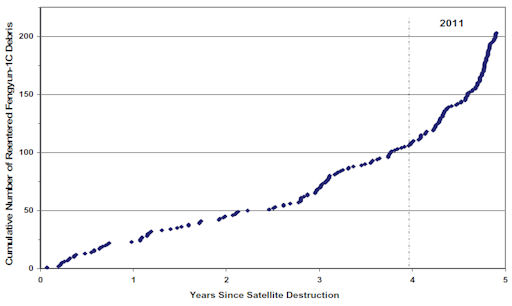CME IMPACT: A coronal mass ejection (CME) hit Earth's magnetic field at 0617 UT on Jan. 22nd. At first the impact did not appear to be a strong one: the solar wind speed barely lifted itself to ~400 km/s when the CME passed by. Now, however, in the wake of the CME, a dense and increasingly geoeffective solar wind stream is blowing around Earth, setting the stage for possible auroras on the night of Jan. 22nd. Aurora alerts: text, voice.
A surge of ground currents in Lofoton, Norway, signaled the CME's arrival, but the impact occurred as the sun was rising--too late for European sky watchers to spy the Northern Lights. In Canada, however, there was a window of visibility:
"It was very cloudy at Lake Laberge north of Whitehorse, but we just happened to get 10 minutes of clear sky not long after the CME hit," reports Phil Hart from the Yukon. "A green corona appeared directly overhead."
more images: from Chad Blakley of Aurora Sky Station, Abisko National Park, Sweden; from Andrei Penescu of Kangerlussuaq, Greenland; from Marketa Stanczykova of Chatanika, Alaska; from Kimberly S Mietzah Damkoehler of Houston, Alaska;
January 2012 Aurora Gallery
[previous Januaries: 2010, 2009, 2008, 2007, 2005, 2004]
INCREASING SOLAR ACTIVITY CLEANS UP SAT-DEBRIS: Earth's atmosphere has been puffing up in response to increasing levels of UV radiation from sunspots. This is good news for satellite operators, because a puffed up atmosphere helps clean up low-Earth orbit. "The number of cataloged debris in Earth orbit actually decreased during 2011," reports Nick Johnson in NASA's Orbital Debris Quarterly newsletter. "[The figure below] illustrates how the rate of debris reentries from the Fengyun-1C anti-satellite test of January 2007 increased during the past year."
"Even though only 6% of the total 3218 cataloged debris from the ill-advised engagement had reentered by the end of 2011, half of these debris fell out of orbit in the past 12 months," he points out. "Likewise, many debris from the 2009 accidental collision of Cosmos 2251 and Iridium 33 are accelerating their departure from Earth orbit. In the absence of a new major satellite breakup, the overall orbital debris population should continue to decrease during 2012 and 2013."

![]()
Solar wind
speed: 435.0 km/sec
density: 9.6 protons/cm3
explanation | more data
Updated: Today at 1333 UT
![]()
X-ray Solar Flares
6-hr max: C3 1255 UT Jan22
24-hr: C7 0257 UT Jan22
explanation | more data
Updated: Today at: 1300 UT
![]()
![]()
![]()
Daily Sun: 22 Jan 12
![]()
![]()
Sunspot 1401 poses a continued threat for M-class solar flares. Credit: SDO/HMI
![]()
![]()
![]()
Sunspot number: 102
What is the sunspot number?
Updated 21 Jan 2012
Spotless Days
Current Stretch: 0 days
2012 total: 0 days (0%)
2011 total: 2 days (<1%)
2010 total: 51 days (14%)
2009 total: 260 days (71%)
Since 2004: 821 days
Typical Solar Min: 486 days
Updated 21 Jan 2012
The Radio Sun
10.7 cm flux: 142 sfu
explanation | more data
Updated 21 Jan 2012
![]()
![]()
![]()
Current Auroral Oval:
![]()
Switch to: Europe, USA, New Zealand, Antarctica
Credit: NOAA/POES
![]()
![]()
![]()
Planetary K-index
Now: Kp= 3 quiet
24-hr max: Kp= 4 unsettled
explanation | more data
![]()
Interplanetary Mag. Field
Btotal: 20.8 nT
Bz: 8.4 nT north
explanation | more data
Updated: Today at 1338 UT
![]()
![]()
![]()
Coronal Holes: 22 Jan 12
![]()
![]()
Solar wind flowing from the indicated coronal hole should reach Earth on Jan. 27-28. Credit: SDO/AIA.
~Incoming Love Codes~
SYMPTOMS OF THE SOLAR FLARES AWAKENING HUMANITY~
1~OVERFLOWING EXPERIENCE OF JOY
2~UNCONTROLLABLE LAUGHTER
3~ROLLING IN THE ISLES
4~PROUDLY WEARING YOUR “WE TOLD YA SO BUTTONS” WITH JOY~
~WE LOVE YOU, LOVE MOTHER AND FATHERGOD AND THE ENTIRE GALACTIC FREE PRESS STAFF~






